This is the final update presentation on anomaly detection in transaction
graphs.
Last Time
In the update presentation, I described the success metric of the precision
recall curve, and implemented three algorithms for outlier detection:
- Global Outlier Detection Algorithm (GLODA)
- Direct Neighbor Detection Algorithm (DNODA)
- Community Neighbor algorithm (CNA)
Since Then
Since then I have extended each algorithm in a few ways:
- Include all data in the graph, not just subset of the dataset that is being
analyzed
- Implement a simple classifier that takes in the results of the graph
algorithms to improve the results of the algorithm more.
- Implemented the final algorithm: OddBall
1
2
3
4
5
6
7
8
9
10
11
| def evaluate(gt, pred):
precision, recall, _ = metrics.precision_recall_curve(gt, pred, pos_label=1)
precision[-1] = precision[-2]
precision[0] = precision[1 % len(recall)]
auc = metrics.auc(recall, precision)
fig, ax = plt.subplots()
fig.suptitle("Precision Recall Curve")
ax.set_xlabel("Recall")
ax.set_ylabel("Precision")
ax.plot(recall, precision)
return auc, ax
|
Loading in the data just as before. However, as we are implementing a
classifier, we are also splitting the data up into a 80% training and 20%
testing set:
1
2
3
4
5
6
7
8
9
10
11
12
13
14
15
16
17
18
19
20
21
22
| pca = decomposition.PCA(n_components=0.8)
filepath = os.path.join(data_root, "elliptic_bitcoin_dataset/")
edgelist = pd.read_csv(os.path.join(filepath, "elliptic_txs_edgelist.csv"))
features = pd.read_csv(os.path.join(filepath, "elliptic_txs_features.csv"), header = None)
classes = pd.read_csv(os.path.join(filepath, "elliptic_txs_classes.csv"))
reduced_features = pd.DataFrame(pca.fit_transform(features.drop(columns=0).values))
reduced_features["txId"] = features[0]
known_classes = classes[classes['class'] != "unknown"].copy()
known_classes['class'] = 2 - known_classes['class'].astype('int32')
D = pd.merge(known_classes, reduced_features, on="txId", how="inner")
D_ids = set(D['txId'])
edge_ids = set(edgelist['txId1']).union(set(edgelist['txId2']))
ids = D_ids.intersection(edge_ids)
known_edgelist = edgelist[ edgelist['txId1'].isin(ids) & edgelist['txId2'].isin(ids)]
D = D[D['txId'].isin(ids)]
train, test = model_selection.train_test_split(D, test_size=0.2)
train_y = train[["txId", "class"]]
train_X = train.drop(columns=["txId", "class"])
test_y = test[["txId", "class"]]
test_X = test.drop(columns=["txId", "class"])
G = nx.from_pandas_edgelist(edgelist, source="txId1", target="txId2", create_using=nx.MultiGraph)
nx.set_node_attributes(G=G, name="D", values=dict(zip(reduced_features["txId"], reduced_features.drop(columns="txId").values)))
|
Improvements to previous models
GLODA
Instead of using LOF, I use a simple naive Bayesian classifier to create
predictions without regard to the graph structure. Needless to say the model
performs much better than before:
1
2
3
4
5
6
7
8
9
10
11
| class GLODA(base.BaseEstimator):
def __init__(self):
self.classifier_ = naive_bayes.GaussianNB()
def fit(self, X = None, y = None):
gt = y['class']
self.classifier_.fit(X, gt)
return self
def predict_proba(self, X = None, y = None):
return self.classifier_.predict_proba(X)[:, 1]
|
1
2
3
4
5
6
7
| knn = 20
M = GLODA()
M.fit(train_X, train_y)
pred_probs = M.predict_proba(test_X)
auc, ax = evaluate(test_y["class"], pred_probs)
print("GLODA AUC: {:.2e}".format(auc))
plt.show()
|
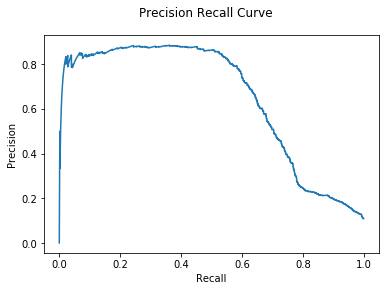
DNODA
In DNODA added to the classifier is data on the direct neighbors in the graph
structure.
1
2
3
4
5
6
7
8
9
10
11
12
13
14
15
16
17
18
19
20
21
22
23
24
25
26
27
28
29
30
31
| class DNODA(base.BaseEstimator):
def __init__(self, G):
self.G_ = G
self.classifier_ = naive_bayes.GaussianNB()
self.generate_distances()
def generate_distances(self):
self.distances_ = {}
node_data = nx.get_node_attributes(G=self.G_, name="D")
for v, d in node_data.items():
neighbors = np.array([node_data[u] for u in self.G_.neighbors(v)])
self.distances_[v] = np.sum(d - neighbors, axis=0) / self.G_.degree(v) + 1
def make_data(self, txIds):
ex = self.distances_[txIds.iloc[0]]
data = np.zeros((len(txIds), len(ex) * 2))
node_data = nx.get_node_attributes(G=self.G_, name="D")
for idx, v in enumerate(txIds):
data[idx] = np.concatenate([self.distances_[v], node_data[v]])
return data
def fit(self, X = None, y = None):
gt = y['class']
ids = y['txId']
data = self.make_data(ids)
self.classifier_.fit(data, gt)
return self
def predict_proba(self, X = None, y = None):
data = self.make_data(y)
return self.classifier_.predict_proba(data)[:, 1]
|
1
2
3
4
5
6
7
| %%time
M = DNODA(G)
M.fit(y=train_y)
pred_probs = M.predict_proba(y=test_y['txId'])
auc, ax = evaluate(test_y["class"], pred_probs)
print("DNODA AUC: {:.2e}".format(auc))
plt.show()
|
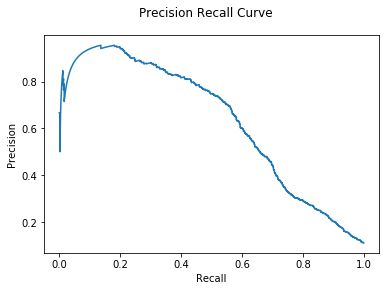
We see significant improvement over last time without a classifier. Let’s see if
CNA gives even more improvement:
1
2
3
4
5
6
7
8
9
10
11
12
13
14
15
16
17
18
19
20
21
22
23
24
25
26
27
28
29
30
31
32
33
34
| class CNA(base.BaseEstimator):
def __init__(self, G):
self.G_ = G
self.classifier_ = naive_bayes.GaussianNB()
self.generate_distances()
def generate_distances(self):
self.distances_ = {}
node_data = nx.get_node_attributes(G=self.G_, name="D")
communities = nx.connected_components(self.G_)
for c in communities:
comm_data = np.array([node_data[u] for u in c])
for v in c:
d = node_data[v]
self.distances_[v] = np.sum(d - comm_data, axis=0) / self.G_.degree(v) + 1
def make_data(self, txIds):
ex = self.distances_[txIds.iloc[0]]
data = np.zeros((len(txIds), len(ex)*2))
node_data = nx.get_node_attributes(G=self.G_, name="D")
for idx, v in enumerate(txIds):
data[idx] = np.concatenate([self.distances_[v], node_data[v]])
return data
def fit(self, X = None, y = None):
gt = y['class']
ids = y['txId']
data = self.make_data(ids)
self.classifier_.fit(data, gt)
return self
def predict_proba(self, X = None, y = None):
data = self.make_data(y)
return self.classifier_.predict_proba(data)[:, 1]
|
1
2
3
4
5
6
7
| %%time
M = CNA(G)
M.fit(y=train_y)
pred_probs = M.predict_proba(y=test_y['txId'])
auc, ax = evaluate(test_y["class"], pred_probs)
print("CNA AUC: {:.2e}".format(auc))
plt.show()
|
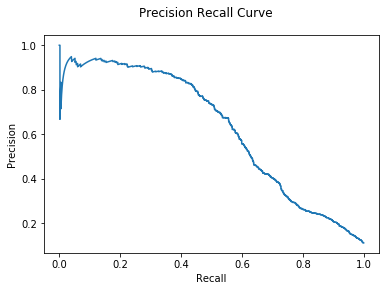
All three algorithms are significantly improved with the help of a classifier.
It is clear that outlier behavior in this dataset is more than just distance
from the average.
Hybrid Model
Similar to the previous update, we make a hybrid model to see if we can improve
our results just a bit more.
1
2
3
4
5
6
7
8
9
10
11
12
13
| class Hybrid(base.BaseEstimator):
def __init__(self, models, agg_fun = lambda x: np.mean(x, axis=0)):
self.models_ = models
self.agg_fun_ = agg_fun
def fit(self, X, y = None):
for m in self.models_:
m.fit(X, y)
return self
def predict_proba(self, X, y = None):
result = [m.predict_proba(X, y) for m in self.models_]
return self.agg_fun_(result)
|
1
2
3
4
5
6
7
| %%time
M = Hybrid(models = [GLODA(), DNODA(G), CNA(G)])
M.fit(X = train_X, y = train_y)
pred_probs = M.predict_proba(X = test_X, y = test_y['txId'])
auc, ax = evaluate(test_y["class"], pred_probs)
print("Hybrid Mean AUC: {:.2e}".format(auc))
plt.show()
|
1
| Hybrid Mean AUC: 6.49e-01
|
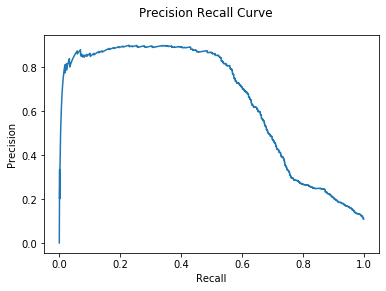
1
2
3
4
5
6
7
| %%time
M = Hybrid(models = [GLODA(), DNODA(G), CNA(G)], agg_fun=lambda x: np.max(x, axis=0))
M.fit(X = train_X, y = train_y)
pred_probs = M.predict_proba(X = test_X, y = test_y['txId'])
auc, ax = evaluate(test_y["class"], pred_probs)
print("Hybrid Max AUC: {:.2e}".format(auc))
plt.show()
|
1
| Hybrid Max AUC: 6.26e-01
|
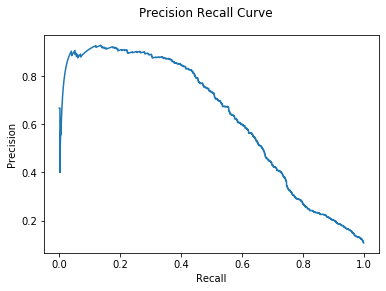
Again, using a Hybrid model gives some small improvement.
OddBall
OddBall works on the observation that real-world graphs typically show a power
law relationship between the number of nodes vs edges or total weight between
nodes in a 1-step neighborhood of each node, which they refer to as an “egonet”.
Let’s observe if a power law relationship is observed in this dataset:
1
2
3
4
5
6
7
8
9
10
11
| def egonet(G, ego, k = 1):
nodes = set()
fringe = set([ego])
for step in range(k):
new_fringe = set()
for v in fringe:
new_fringe = new_fringe.union(G.neighbors(v))
nodes = nodes.union(fringe)
fringe = new_fringe.difference(nodes)
nodes = nodes.union(fringe)
return nodes
|
1
2
3
| egonets = []
for ego in G.nodes():
egonets.append(egonet(G, ego))
|
1
2
3
4
5
6
7
8
9
10
11
12
13
14
15
16
17
18
19
20
21
| x = []
y = []
for e in egonets:
x.append(len(e))
y.append(len(G.edges(nbunch=e)))
x_log = np.log(x)
y_log = np.log(y)
m, b = np.polyfit(x_log, y_log, 1)
x_fit = np.unique(x_log)
y_fit = m * x_fit + b
plt.title('Power Law of Nodes vs. Edges')
plt.plot(x, y, 'o', label="data")
plt.plot(np.exp(x_fit), np.exp(y_fit), label="fit")
plt.xscale('log')
plt.yscale('log')
plt.xlabel('Number of Nodes')
plt.ylabel('Number of Edges')
plt.legend(loc='upper left')
plt.show()
|
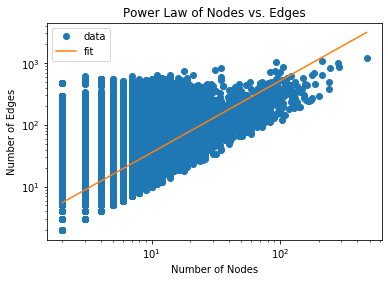
1
2
3
4
5
6
7
8
9
10
11
12
13
14
15
16
17
18
19
20
21
22
23
24
25
| x = []
y = []
node_data = nx.get_node_attributes(G, "D")
for e in egonets:
distance = 0
for v, u in G.edges(nbunch=e):
distance += np.sum(np.sqrt(np.sum(np.square(node_data[v] - node_data[u]), axis= 0)))
x.append(len(e))
y.append(distance)
x_log = np.log(x)
y_log = np.log(y)
m, b = np.polyfit(x_log, y_log, 1)
x_fit = np.unique(x_log)
y_fit = m * x_fit + b
plt.title('Power Law of Nodes vs. Total Node Weight')
plt.plot(x, y, 'o', label="data")
plt.plot(np.exp(x_fit), np.exp(y_fit), label="fit")
plt.xscale('log')
plt.yscale('log')
plt.xlabel('Number of Nodes')
plt.ylabel('Total Weight')
plt.legend(loc='lower right')
plt.show()
|
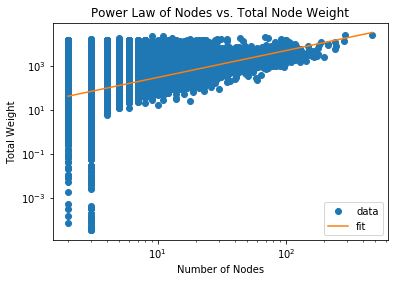
Notice that the majority of the data fits a powerlaw distribution rather
accurately. We will identify outliers by ranking nodes by how far they deviate
from the best fit line for each $ x,y $ pair and the best-fit power law equation
$ y = Cx^\theta $ where $C, \theta$ are the constants to fit. Our outlier score
becomes:
\[score(i) = \frac{\max (y_i, Cx_i^\theta) }{\min (y_i, Cx_i^\theta)} \cdot
\log(| y_i - Cx_i^\theta | + 1)\]
1
2
3
4
5
6
7
8
9
10
11
12
13
14
15
16
17
18
19
20
21
22
23
24
25
26
27
28
29
30
31
32
33
34
35
36
37
38
39
40
41
42
43
44
45
46
47
48
49
50
51
52
53
54
55
56
57
58
59
60
61
62
63
64
65
66
67
68
69
70
71
72
73
74
| class OddBall(base.BaseEstimator):
def __init__(self, G):
self.G_ = G
self.generate_subgraphs()
self.generate_xy_pairs()
self.generate_best_fit_params()
self.compute_scores()
def generate_subgraphs(self):
self.egonets_ = []
self.egos_ = []
for v in self.G_.nodes():
if self.G_.degree(v):
S = egonet(self.G_, v)
self.egos_.append(v)
self.egonets_.append(S)
def generate_xy_pairs(self):
self.nodes = []
self.edges = []
self.weights = []
node_data = nx.get_node_attributes(G, "D")
for e in egonets:
distance = 0
num_edges = 0
for v, u in G.edges(nbunch=e):
distance += np.sum(np.sqrt(np.sum(np.square(node_data[v] - node_data[u]), axis= 0)))
num_edges += 1
self.nodes.append(len(e))
self.edges.append(num_edges)
self.weights.append(distance)
def generate_best_fit_params(self):
self.params = []
nodes_log = np.log(self.nodes)
edges_log = np.log(self.edges)
weights_log = np.log(self.weights)
# fit poly1d for nodes vs. edges and nodes vs. weight
m, b = np.polyfit(nodes_log, edges_log, 1)
edge_theta = m
edge_C = np.exp(b)
m, b = np.polyfit(edges_log, weights_log, 1)
weight_theta = m
weight_C = np.exp(b)
self.params = [(edge_C, edge_theta), (weight_C, weight_theta)]
def compute_scores(self):
self.scores_ = {}
(edge_C, edge_theta), (weight_C, weight_theta) = self.params
for v, n, e, w in zip(self.egos_, self.nodes, self.edges, self.weights):
edge_inf = edge_C * (n ** edge_theta)
weight_inf = weight_C * (e ** weight_theta)
edge_score = max(edge_inf, e) / min(edge_inf, e) * np.log(np.abs(edge_inf - e) + 1)
weight_score = max(weight_inf, w) / min(weight_inf, w) * np.log(np.abs(weight_inf - w) + 1)
self.scores_[v] = (edge_score, weight_score)
def score(self, v):
return self.scores_[v]
def fit(self):
return self
def predict_proba(self, X = None, y = None):
ret = []
for txid in y:
ret.append(self.scores_[txid][1])
return ret
|
1
2
3
4
5
6
| %%time
M = OddBall(G)
pred_probs = M.predict_proba(y=test_y['txId'])
auc, ax = evaluate(test_y["class"], pred_probs)
print("OddBall AUC: {:.2e}".format(auc))
plt.show()
|
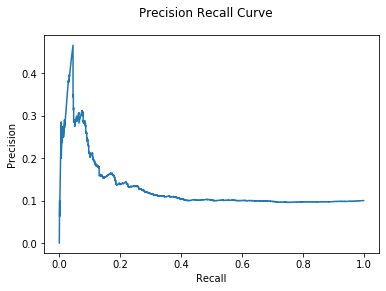
Unfortunately, our model is not good at predicting illicit behavior in this
dataset. However, as we already saw, identifying illegal behavior has more
nuance than just identifying outliers. Let’s focus on use cases where OddBall
thrives:
Use Cases of OddBall
The paper which describes the OddBall algorithm used a few different graphs to
highlight its strenghts:
- The Enron graph to identify noteworthy
senders and recipients of emails. OddBall can use the power law theorem of
nodes vs.
- Data from the
Federal Election Commission
to identify large donors and recipients of super PAC money.
OddBall on Enron
1
2
| enron = nx.read_edgelist(os.path.join(data_root, 'Enron', 'Enron.txt'), create_using=nx.DiGraph)
enron.size(), enron.order()
|
1
2
3
4
5
6
7
8
9
10
| x = []
y = []
nodes = []
for ego in enron.nodes():
S = egonet(enron, ego)
e = len(enron.edges(nbunch=S))
if len(S) > 0 and e > 0:
x.append(len(S))
y.append(e)
nodes.append(ego)
|
1
2
3
4
5
6
7
8
9
10
11
12
13
14
15
16
17
| x_log = np.log(x)
y_log = np.log(y)
m, b = np.polyfit(x_log, y_log, 1)
C = np.exp(b)
theta = m
x_fit = np.unique(x)
y_fit = C * (x_fit ** theta)
plt.title('Power Law of Nodes vs. Edges')
plt.plot(x, y, 'o', label="data")
plt.plot(x_fit, y_fit, label="fit")
plt.xlabel('Number of Nodes')
plt.ylabel('Number of Edges')
plt.xscale('log')
plt.yscale('log')
plt.legend(loc='lower right')
print(theta, C)
plt.show()
|
1
| 1.1898532131269226 45.424433441186316
|

1
2
3
4
| scores = []
for v, X, gt in zip(nodes, x, y):
inference = C * (X ** theta)
scores.append( (max(gt, inference) / min(gt, inference)) * np.log(np.abs(gt - inference) + 1) )
|
1
| np.array(nodes)[np.argsort(scores)[-10:]]
|
1
2
| array(['36163', '36150', '8344', '36135', '9137', '20764', '33806',
'5069', '5022', '5038'], dtype='<U5')
|
These are the 10 most out-of-place nodes, according to OddBall focusing on the
power law of nodes vs. edges. i.e., these are nodes who’s neighborhood has a
widely outlying number of edges given its size (it is eigther a near star, or a
near clique, both of which are unlikely in large real-world graphs) OddBall can
quickly identify these nodes as particularly outstanding nodes. Pairing up the
node ids with users shows that the highest outlier pertain to the at the time
CEO Kenneth Lay.
OddBall on Political Candidate Donation Data
Here we make use of the power law theorem concerning edge weight to identify
large donors or large committees receiving donations.
1
2
| donations = nx.read_edgelist(os.path.join(data_root, "donations", "donations.csv"), delimiter=",", data=[("amount", float)], create_using=nx.DiGraph)
donations.size(), donations.order()
|
1
2
3
4
5
6
7
8
9
10
11
| x = []
y = []
nodes = []
for ego in donations.nodes():
S = egonet(donations, ego)
weights = [d['amount'] for _, _, d in donations.edges(nbunch=S, data=True)]
totalweight = sum(weights)
if len(weights) > 0 and totalweight > 0:
nodes.append(ego)
x.append(len(weights))
y.append(totalweight)
|
1
2
3
4
5
6
7
8
9
10
11
12
13
14
15
16
17
| x_log = np.log(x)
y_log = np.log(y)
m, b = np.polyfit(x_log, y_log, 1)
C = np.exp(b)
theta = m
x_fit = np.unique(x)
y_fit = C * (x_fit ** theta)
plt.title('Power Law of Edges vs. Total Node Weight')
plt.plot(x, y, 'o', label="data")
plt.plot(x_fit, y_fit, label="fit")
plt.xlabel('Number of Edges')
plt.ylabel('Total Weight')
plt.xscale('log')
plt.yscale('log')
plt.legend(loc='lower right')
print(theta, C)
plt.show()
|
1
| 0.8318466425038167 1102.3570364147965
|

1
2
3
4
| scores = []
for v, X, gt in zip(nodes, x, y):
inference = C * (X ** theta)
scores.append( (max(gt, inference) / min(gt, inference)) * np.log(np.abs(gt - inference) + 1) )
|
1
| np.array(nodes)[np.argsort(scores)[-10:]]
|
1
2
3
| array(['C00553164', 'C00544007', 'C00637785', 'C00697227', 'C00571703',
'C00701656', 'C00490847', 'C00657866', 'C00489815', 'C00693382'],
dtype='<U9')
|
These are the committees that have significantly high contributions from a fewer
number of powerful contributors. These committees are in order of highest to
lowest outlier scores:
- C00693382: DEMOCRACY PAC
- C00489815: NEA ADVOCACY FUND
- C00657866: PROTECT FREEDOM POLITICAL ACTION COMMITTEE
- C00490847: WORKING FOR WORKING AMERICANS FEDERAL
- C00701656: ENGAGE TEXAS
- C00571703: SENATE LEADERSHIP FUND
- C00697227: ELECT HENRY HEWES 2020
- C00637785: D.D. ADAMS FOR CONGRESS
- C00544007: FRIENDS OF ROY CHO INC.
- C00553164: DAVID M ALAMEEL FOR UNITED STATES SENATE
Conclusion
Depending on what you want to identify, outlier detection can be a challenging
task with a bunch of different angles one can take to solve the problem. Each
algorithm mentioned here has its merits and drawbacks, and each could in the
right context do well to identify certain outliers given the right input data
and search parameters.












